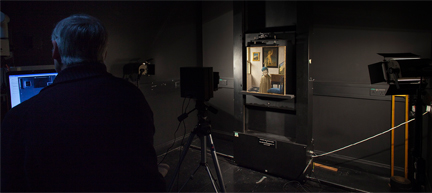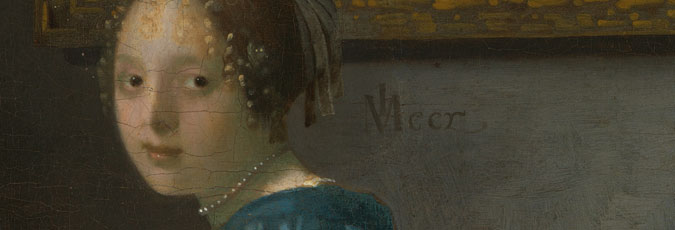Technical imaging
Infrared imaging of paintings (IRR)
Infrared is the name given to the part of the electro-magnetic spectrum between visible light and microwaves. Radiation in the near-infrared region (750nm–2500nm) is similar to visible light but has slightly longer wavelengths and lower energy. Infrared radiation cannot be seen by humans so imaging techniques must be used to make it visible.

Near-infrared radiation, with its wavelengths longer than those of visible light, is often able to penetrate paint layers which are opaque to the human eye. The radiation passes through the paint until either it reaches something that absorbs it or it is reflected back to the camera. Usefully for the study of paintings carbon black is highly absorbing in the near-infrared region while many of the other pigments used by artists get increasingly transparent to radiation of longer wavelengths. If an artist has begun a painting by drawing the design in black on a white ground and then painted over it, an infrared image of that painting will show the underdrawing clearly (provided that the paint on top does not contain anything infrared absorbing).
X-radiography
X-rays are a type of radiation, not visible to the naked eye, which can be used for analysing aspects of a work of art. X-rays can pass through most solid objects, but they are obstructed by certain materials. The heavier the atoms of a substance, the more resistance it has to X-rays. An X-radiograph records the areas of a work where the X-rays have been impeded (these areas appear white when printed as a photographic positive). Pigments containing heavy metals such as lead and mercury show up, as do the nails used in the construction of a painting's support.
X-radiographs are useful for revealing changes that may have occurred at different stages in the development of a painting; losses to the paint layer show as dark areas. X-radiographs can be difficult to interpret because the image shows all of the layers of the work superimposed.1
View zoomable X-radiographs of Vermeer's Young Woman standing at a Virginal and Young Woman seated at a Virginal
http://www.nationalgallery.org.uk/media/15498/padfield_saunders_cupitt_atkinson2002.pdf

